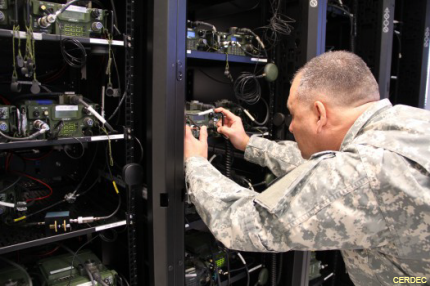Army's virtual model shows how new tech affects tactical networks
CERDEC's modeling and simulation tool tests live hardware in a virtual environment, which can cut costs and development times.

A live radio is tested in MODESTA's virtual environment.
The military discovered long ago that simulations were an effective and affordable way of training warfighters for new situations. And the same principle can apply to new devices on a network.
The Army’s Communications-Electronics Research, Development and Engineering Center is doing just that, with a simulation framework that allows for the testing of hardware devices in a virtual environment. The Modeling, Emulation, Simulation Tool for Analysis, or MODESTA, provides a way to test devices in a scaled environment running real-world applications in a variety of scenarios, which could help identify potential trouble spots before actual deployment—or, for that matter, a large-scale acquisition of product.
In a post on the Defense Department’s Armed with Science website, two CERDEC engineers, Joshua Fischer and Noah Weston, write that MODESTA could save a significant amount of money by eliminating redundant analyses and duplicative spending. And it will allow acquisition officials to work with engineers to evaluate a device’s impact in terms of such things as threats or how it will function within a tactical network.
Fischer and Weston note that brining new technologies or devices to a network isn’t always a smooth ride—glitches can and do occur. That, along with the increasing complexity the Army’s networks, creates the need for a system-of-systems approach to the early stages of integrating those technologies, which could range from new types of sensors, routers or tactical radios to communications with unmanned aerial systems or vehicles.
MODESTA has a modular framework that allows engineers to emulate an array of systems, such as mission command systems, cyber systems—offensive or defensive—weapons applications and tactical systems such as the Distributed Common Ground System-Army. The emulation can be scaled to practically any size and configured to mimic different scenarios and variables, such as different environmental settings, giving testers a good idea of how, say, a radio will interact with the full-blown, real-world network.
In addition to letting the Army make an informed decision on whether to purchase a product, the engineers said MODESTA testing also could help with a product under development, highlighting areas that might need improvement before it goes into full production.
“Working under the MODESTA framework will create cost efficiencies in licensing, waveform development, server costs and maintenance, and the man hours needed to set up varying analyses,” Fischer and Weston write. “The end state could reduce spending by as much as 80 percent.”
They said they’re planning on having initial capability for a brigade-level modeling and simulation environment by January 2015, and a division-level model a year later. An Army Corps-sized system could follow after that.